- Summary
--------------------------------------French
version
-
-
-
-
|
SURFACE
TENSION and GLAZING
|
-
-
- Translated by Sir Edouard
Bastarache
- Tracy, Québec,
CANADA
- edouardb@colba.net
-
-
- Gibbs' Theorem
:
-
- According to the principles
of thermodynamics, the elements which make up the
surface layer of a solution and those of its mass are
different.
-
- Surface Tension :
-
- It is a force resulting from
cohesiveness, which lowers to a minimum the number of
molecules on the surface of a liquid. This creates a
kind of invisible enveloppe which occupies the
smallest possible surface. The surface tension
represents the force of the film on the liquid
surface.
- When one applies this
principle to a minerals suspension, one can observe
that the surface tension of water creates on the
surface a layer which contains the finest particles of
the suspension. This layer is very thin and created
spontaneously.
-
-
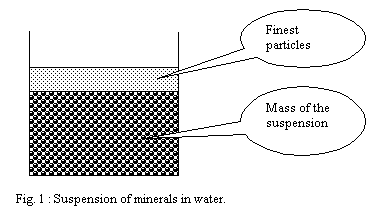 -
-
- Application to an
isolated drop of the suspension :
-
- A drop is a volume of
insulated liquid whose cohesion is ensured by the
forces of surface tension. In the absence of external
influence, the drops have a spherical form.
-
-
-

-
-
- Thus if one applies this
reasoning to a drop of this suspension, the finest
particles come to cover the surface of this one and
leave in the centre a mass of a suspension richer in
large particles.
-
- Influence of drops size
:
-
- Surface of a sphere : 4 p
R2
- Volume of a sphere : 4/3 p
R3
- Ratio surface / volume : 4 p
R2 / 4/3 p R3 = 3 /
R
-
- The ratio of the surface
compared to the volume is 3 times the inverse of the
radius of the sphere, which means that the volume
of a drop (sphere) is reduced more quickly than its
surface when its radius decreases.
- Ex: drops of 1 mm of radius
will have a ratio surface/volume of 3 cm² per ml
of suspension while drops of 0.5 mm of radius will
have a ratio surface/volume of 6 cm² per ml of
suspension.
- Thus, for increasingly small
drops formed from a suspension of minerals, these will
present an increasingly significant differential of
composition between the minerals of the surface and
those of their mass (heart of the drops). The force of
the surface tension exerting on the surface will
impoverish more and more the mass of its finest
minerals, since the volume of the drops decrease more
quickly than their surface.
-
- Glazing
-
- Glazing by spraying :
-
- The principle is to disperse
a suspension of drops in the air in order to direct
those towards the surface of the ware to be glazed.
The strong dispersion of the suspension helping with
better controlling the application.
-
-
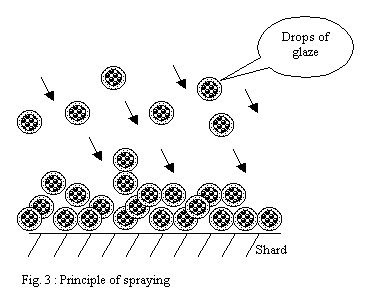 -
-
- The drops pile up on the
surface and form a layer.
- - If the shard is very
porous, the drops will be solidified progressively as
they settle and will form a powdery heap.
- - If the shard is less
porous or if the flow of pulverization is too
important the drops will have time to form a "wet"
layer leaving time necessary to the partial
reorganization of particles under the effect of
surface tension forces.
-
-
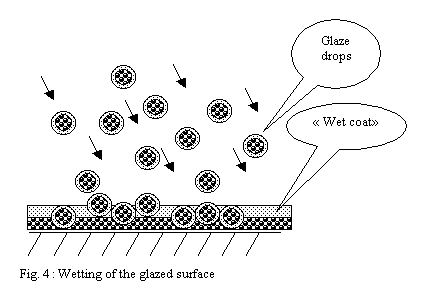 -
-
- Glazing by dipping
:
-
- One dips the porous shard to
be glazed in a bath of glaze in suspension in water.
The capillarity forces of the shard make it possible
for the water to penetrate into this one, attracting
and thus plating minerals of the solution on the
porous surface.
-
-
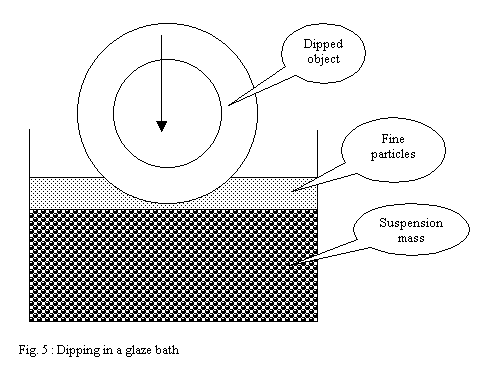 -
-
- The case of dipping differs
much from spraying. The layer deposited by capillarity
on the shard is partly made up of the finest particles
attracted onto the surface of the bath by the force of
surface tension of the suspension. These finest and
very mobile particles wrap the dipped ware as it
progressively penetrates the glaze bath.
-
- They form, just like a clay
slip on the plaster of a mould, a " super fine casting
skin ". But in the case of dipping this " super fine
casting skin " is inserted between the shard and the
external glaze coat made up of the particles of the
mass, larger in size and denser.
-
-
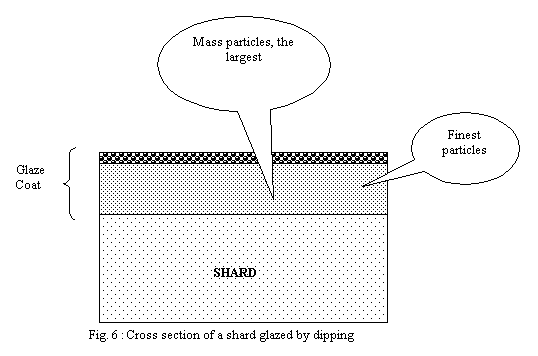 -
-
- Influence of the
glazing method on the behavior of the glaze:
-
- The two methods quoted on
this page lead to different results during firing of
the glaze. The forces of surface tension play a
dominating role in the results by allowing a layout
and a different selection of the particles deposited
on the shard. The aspect of the fired layer and the
dynamics of its fusion during firing will be different
according to the method used.
- Thus for the same
composition of a glaze (identical minerals in same the
proportions) fired in an identical cycle of firing one
will be able to observe:
-
- 1) Spraying
:
-
- a) powdered layer :
-
- The powdered layer is made
up of glaze granules of different sizes, each one
covered by a thin layer of fine particles. The fine
particles melt in the first place and quickly attack
the mass of less bulky drops. Thus small drops melt
before the largest and start the heterogeneous fusion
of the glaze, forming fusible points distributed in
all the mass of the product.
- These fusible points
accelerate the fusion of slightly larger drops located
near their vicinity and so on. It follows a phenomenon
of reticulation of the layer leading to clusters in
large viscous molten drops. This discontinuous layer
is permeable and allows gases located in the shard to
escape easily.
- With temperature rising, the
forces of surface tension are slowly slackened, making
it possible to clusters to join and form a continuous
layer. This last phase in general makes it possible to
obtain glaze healing over by carrying out a stage of
firing at the highest temperature during a certain
time.
-
-
 -
-
 -
-
- b) Wet layer of sprayed
glaze :
-
- The wet layer is a tangle of
drops whose continuity produced in the upper part at
the time of wetting made it possible that the finest
particles form a layer under the action of the forces
of surface tension. Thus part of the fine particles
had the time to organize on the surface of the layer
and form a smooth and compact "skin".
- During firing, this compact
surface layer will begin to melt before the whole of
the layer and will undergo strong contractions under
the effect of shrinking and the high surface tension
of the glaze in formation. The under-layers being at a
stage of less advanced softening, the cohesion of this
not very homogeneous mixture will allow ruptures of
the layer in fusion leading to cracks and retractions.
- These discontinuities of the
layer of the glaze will allow gases to escape. Then
the temperature continuing to rise, the whole will end
up forming a continuous layer and heal over.
-
-
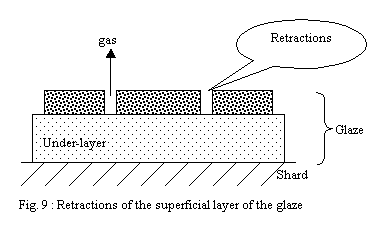 -
-
- 2) Dipping
:
-
- The layer of the finest
particles in direct contact with the shard will melt
in first place. The strong cohesion of the shard will
prevent the retraction of the softened layer and this
one will form a relatively continuous and tight
envelope. The gases which will want to escape the
shard will have trouble to find a way through the
layer of the glaze and will accumulate.
- If the layer of the glaze is
thin, discontinuities (small holes) will let gases
leave more erasily.
- If it is thick,
discontinuities will be rare and the pressure of the
gases will rise up to reach and exceed the bearable
limit of the layer of the glaze strongly softened by
temperature. Large bubbles will explode on the
surface, producing craters of a few millimetres.
-
-
-
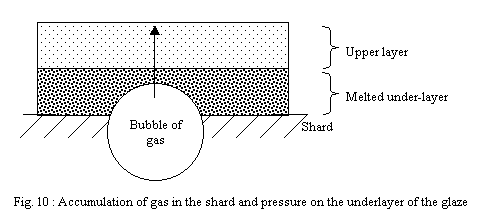 -
-
- For this reason, the
pieces produced by dipping will have to be subjected
to a rigorous control of the thicknes of the glaze,
especially if the shard produces gases during firing.
A very detailed attention will have to be paid to the
granulometry and the grinding of the glaze.
-
-
-
- Smart2000.fr
©
Octobre 2002
-
FRANCE
- Écrit
et documenté par le propriétaire du site
// Contact : Smart2000@wanadoo.fr
- Document
pour CONSULTATION PRIVÉE
uniquement
- Toute
reproduction totale ou partielle est
interdite
-
-
-
-
- Smart2000.fr
le site
dédié aux passionnés de
céramique
-
- Smart2000
- FRANCE sur https://smart2000.fr/
-
- This
entire page Copyright © 2002-2023, All Rights
Reserved.
- Les
textes et les photos restent la
propriété de leur auteurs, ils ne
peuvent être réutilisés sans un
accord préalable. Nous
consulter.
|